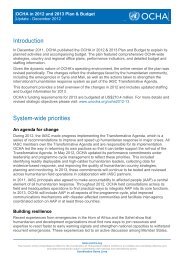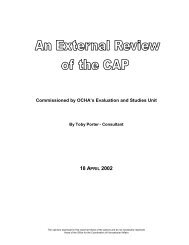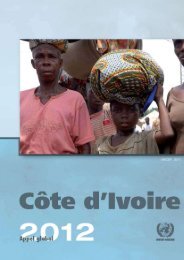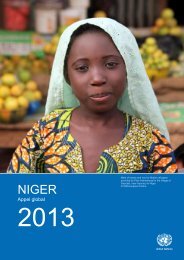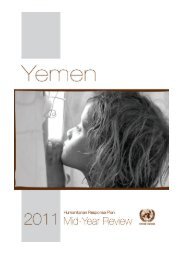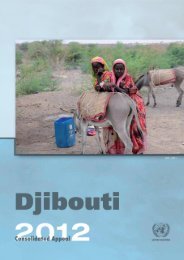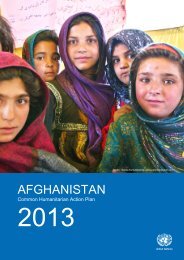Table of contents
Untitled
Untitled
Create successful ePaper yourself
Turn your PDF publications into a flip-book with our unique Google optimized e-Paper software.
14[1] 2011 in review | changes in the context United Nations and PartnersSudan work plan 2012withdrew its 700 strong police contingent from Abyei andSudan withdrew 300 <strong>of</strong> its armed forces and police presencein May. Efforts have been made by humanitarian organizationsto address the needs <strong>of</strong> both the DinkaNgok and theMisseriya population in the Abyei area.Returns to Abyei town commence but accessremains limitedWhile the majority <strong>of</strong> the 109,000 people who fled Abyei lastyear remain displaced, UNISFA reported that some 9,000people returned to the Abyei area during the first half <strong>of</strong> 2012.Of these, 7,500 people returned to the outlying villages south <strong>of</strong>Abyei town, while around 1,500 people returned to Abyei townin March . The presence <strong>of</strong> SAF (who have since departed), therisk from landmines and unexploded ordinance (UXO), foodsecurity concerns and the lack <strong>of</strong> livelihoods opportunitiesremained the main factors hindering large-scale return.There was also displacement into Abyei during the first half <strong>of</strong>the year. Following reports <strong>of</strong> SAF aerial bombing in Unity State,South Sudan in early April; UNISFA reported that around 3,000people fled into the Abyei area.Humanitarian access to Abyei is restricted from Sudan .Currently, the vast majority <strong>of</strong> assistance is being provided byhumanitar¬ian organizations based in South Sudan . The presence<strong>of</strong> land¬mines and UXOs continues to cause concernand constrain the movements <strong>of</strong> humanitarian organizations inAbyei.UNSIFA mandate renewedThe UN Security Council renewed UNISFA’s mandate fora further six months in late May. The Council will review themandate and composition <strong>of</strong> UNISFA after a four monthperiod based on the level <strong>of</strong> progress made by the parties indemilitarizing Abyei, activating border security mechanisms,and establishing the Abyei Area Administration.PEOPLE OF SOUTH SUDANESEORIGIN IN SUDANFramework Agreement on Four FreedomsSudan and South Sudan initialled a framework agreementin March on the four freedoms’ <strong>of</strong> residence, movement,prop¬erty rights, and freedom to undertake economic activitywith respect to their nationals in the two countries inaccordance with the laws and regulations <strong>of</strong> each state. Thetwo govern¬ments agreed to form a High Level Committee(HLC) to over¬see implementation <strong>of</strong> the agreement, but thecommittee has yet to meet.End <strong>of</strong> Transition Period; uncertainty remainsThe Government <strong>of</strong> Sudan's transitional period for people<strong>of</strong> South Sudanese origin remaining in Sudan to regularizetheir status ended on 8 April amid considerable uncertainty.The vast majority <strong>of</strong> people <strong>of</strong> South Sudanese origin wereunable to regularize their status during the transitional period,as they had neither valid documentation nor the means totravel to South Sudan. By the end <strong>of</strong> April, however, the SouthSudan Embassy had commenced issuing emergency traveldocu¬ments to enable people <strong>of</strong> South Sudanese origin totravel to South Sudan to acquire nationality documentation;by the end <strong>of</strong> May, around 3,000 travel documents were issuedand the embassy had started processing passport applicationsand nationality certificates.Partners in the Protection Sector recognise that the safety andsecurity <strong>of</strong> people <strong>of</strong> South Sudanese origin is a concern giventhe uncertainty surrounding their rights to residency, citizenshipand basic services, as well as their right to return in safetyand dignity to South Sudan. Due to the limited options forreturn and the lack <strong>of</strong> access to basic services at departurepoints, as well as the tense situation in April/May betweenSudan and South Sudan, resulting from the events in Higlig,vulnerability at most departure points and in transit has beena concern. UNHCR also report that there has been a number<strong>of</strong> abductions and detention <strong>of</strong> people <strong>of</strong> South Sudaneseorigin by South Sudanese militia groups eager to acquire newrecruits for activities in South Sudan.Following the end <strong>of</strong> the transition period, concerns alsoremain as to how people <strong>of</strong> South Sudanese origin will be ablefatality trends DarfurFatalities by year (Darfur)Documented fatalities per yearFatalities by month (Darfur)Documented fatalities, period Jan ‘08 to Oct ‘11Fatalities by statePeriod Jan-Apr 2012Fatalities by causePeriod Jan-Apr 201217102321600450State # %North 67 20South 195 57West 79 23Total 341 100Cause # %Armed conflict 173 51Tribal / res. clash 15 4Crime / accidents 153 45Total 341 10020088752009201091520113412012Jan-08Apr-08Jul-08Oct-08Jan-09Apr-09Jul-09Oct-09Jan-10Apr-10Jul-10Oct-10Jan-11Apr-11Jul-11Oct-11Jan-12Apr-123001500Source: UNAMID Joint Mission Analysis Centre (JMAC), Monthly Threat Assessment Reports (2009-2012); * 2012 data for Jan-Apr




